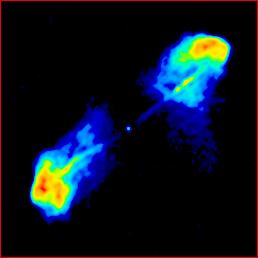 Image:
Image:3C 438 | B2153+377 |
| S178 | Alpha | FR | Class | ID | Spectrum | Best z | mag. | LAS | lg P178 | D |
|---|---|---|---|---|---|---|---|---|---|---|
| 48.7 | 0.88 | II | RD | Gal | 0.290 | R(c) = 17.90 | 23.20 | 26.84 | 83.3 |

| Size: | 23.0 × 23.0 arcsec² |
|---|---|
| LUT: | Linear |
| Beam: | 0.29 arcsec |
| Frequency: | 1534 MHz |
| Method: | CLEAN/VTESS’ėˇ>0.29
|
| Telescope: | MERLIN/VLA |
| Credits: | Leahy (1997) |
The jets are very well collimated (they are best seen on our high-resolution supplementary image). The northern jet has three prominent knots, whose peaks are noticably off the jet axis. The southern jet brightens significantly from the bend about six arcsec from the core, and the jet seems to be brighter on the outside edge of the bend (this weak effect is at the limit of believability). If real, this suggests that the jet material is flowing around the bend in response to a pressure gradient, as opposed to ballistic models in which each part of the jet moves at constant velocity away from the core, so that bends indicate changes in the direction of ejection. Because of the strong depolarization, the magnetic field orientation is unknown.
The faint extension to the south from the north-west lobe is best seen in our C20 image.
The AGN powering 3C 438 is remarkably weak in the optical, with even narrow emission lines only just detected (Rawlings et al. 1989a). Surprisingly, 3C 438 is a relatively strong X-ray source (Feigelson & Berg 1983, Prieto 1996), but since the the host galaxy is in a cluster (Burbidge & Crowne 1979, de Koff et al. 1996) the X-rays may be from the ICM rather than the AGN. If so, this would be a massive cluster atmosphere, comperable to a rich Abell cluster. A very dense surrounding medium is also consistent with the strong depolarization. It may also explain why such a high-power DRAGN should have a relaxed double structure, which is normally found in objects with powers around the FR break. A very high pressure in the ambient medium will raise the lobe pressure, which in turn may lead to increased dissipation in the jets, reducing the energy flux available to power hotspots. At the same time the hotspot prominence is reduced anyway because high-pressure lobes will be relatively bright in the radio.
Weak fine-scale structure is undersampled
in our supplementary full-resolution image
and should not be relied on. The weak striping
parallel to the jets is an artifacts, but there are
features in the southern lobe that are not exactly parallel to the jet
and are probably real.
| Prev. | Data Page | Other images | Next | Search | Alphanumeric List | Icon List | Atlas Index |
|---|